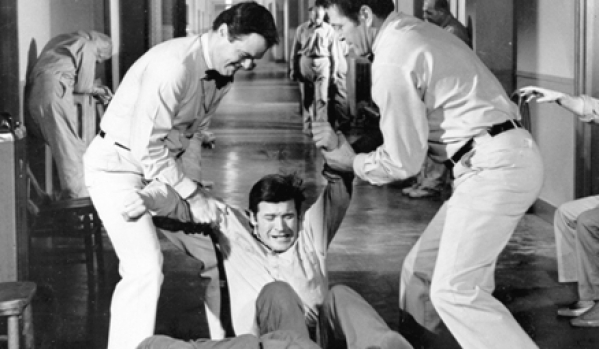Did your dog die? There’s a pill for that. Did your wife leave you for the mailman? There’s a pill for that, too. Missed out on that promotion? There’s a pill waiting for you! Saddened or frustrated by financial problems? Having a rough week or month? Well, there’s no need to face your problems head-on anymore—because we have a pill for everything now.
Medicating Americans for mental illness has exploded over the past decade, and now 1 in 5 adults take at least one psychiatric drug, whether it’s an antipsychotic, anti-anxiety medication, or antidepressant.  These numbers come straight from pharmacy claims data.
These numbers come straight from pharmacy claims data.
One of the most concerning trends is the massive increase in the use of powerful antipsychotic drugs across all age groups, as well as a sharp rise in adult use of drugs for ADD—a condition traditionally diagnosed in children. From 2001 to 2010, psychiatric medicine use in adults grew by 22 percent. While most psychiatric drug use surged, antidepressant prescriptions in children and anxiety medications for the elderly actually declined, mostly due to the dangerous side effects in those age brackets. In 2004, the FDA finally required a black box warning and admitted the ongoing side effect of suicidal thoughts in children and teens taking antidepressants—literally driving some to end their lives. Yes, these drugs are that powerful.
Psychiatric medications are now among the most widely prescribed and profitable drugs on the market. If anyone has updated stats, please share them, but as of 2010 Americans spent over $16 billion on antipsychotics (for bipolar, depression, schizophrenia), another $11.6 billion on antidepressants, and $7.2 billion on ADHD drugs, according to IMS Health. That’s over $34 billion in sales in 2010 alone. Can you see how much money is being generated here?
Trillions of dollars over a decade—can you even fathom that? Our national debt is being spent on psych meds. It makes perfect sense for pharmaceutical companies to align with doctors and health organizations to push this gold mine.
Big Pharma now spends over 5 billion dollars annually to send sales reps to doctors’ offices across the country. These sales reps keep files on physicians, including personal details like family members, fashion sense, taste in music, and favorite sports teams. Gifts like all-expense-paid trips, sporting events, and other perks are commonplace. “Dinner nights” are routine—I know from experience. I lost count of the times drug reps would take a friend of mine and her entire nursing staff out for fine dining and wild nights. Maybe they didn’t supply the cocaine, but they provided everything else—this is a fact I can personally prove. So if national media says otherwise, it means nothing to me. Every party, dinner, and bar tab—all paid for by drug reps. What do they want in return? For doctors to prescribe their drugs. The nurses enjoy the perks, the doctors get luxury box tickets, and the drug reps secure prescriptions for their meds.
The New York Times reported that psychiatrists in Vermont and Minnesota topped the charts for accepting pharmaceutical company gifts, coinciding with a surge in “atypical” antipsychotic use in children. From 2000 to 2005, payments to Minnesota psychiatrists increased sixfold to $1.6 million, while antipsychotic prescriptions to children skyrocketed ninefold.  Do you see a connection? What makes me sick is how they’re using our children’s brains to fatten their profits. This leads to the next big problem: Are psychiatric medicines actually causing more mental illness?
Do you see a connection? What makes me sick is how they’re using our children’s brains to fatten their profits. This leads to the next big problem: Are psychiatric medicines actually causing more mental illness?
There was an interview with veteran investigative reporter and author of Mad in America, Robert Whitaker. Here’s a powerful statement from him:
The story that people with mental disorders have known chemical imbalances, that’s a lie. We don’t know that at all. It’s just something that they say to help sell the drugs and help sell the biological model of mental disorders.
He adds:
There’s a built-in economic incentive to define mental illness in the broadest terms possible, and to find ordinary, distressing emotions or behaviors that some people may not like and label them as mental illness.
Whitaker also quotes a leading neuroscientist who concludes that psychotropic drugs actually create brain chemistry imbalances.
Have you ever looked at the side effects of drugs like Risperdal, Haldol, Paxil, Ritalin, and others? The list is terrifying. Any real sense of relief is usually short-term and often placebo. Physical side effects include diabetes, heart attacks, and sudden death. Mental side effects can be anxiety, insomnia, and violent behavior. The increased suicide rate among traumatized veterans is directly linked to psychiatric drugs. Look at some of America’s most notorious killers—most have a history with psychiatric drugs. As I’ve said, we’re drugging our children for profit, then wondering why they’re “snapping” more than ever before. All doctors need to prescribe a psychiatric drug is for a patient to fit a specific behavior profile. So, did your dog die? That’s extreme sadness. Here’s a pill for that. If you experience extreme side effects or feel suicidal after withdrawal, you can just take another pill for that. Just don’t kill yourself—or someone else—in the process.
So, are these acts of violence happening because of mental health issues, or because of the adverse effects of mental health drugs, especially during withdrawal? We’ll never know, because we’ll never see the part of the autopsy that shows whether these killers were in the middle of psychotropic withdrawal. It’s said that most side effects surface when the user stops taking the medicine. But anyone with common sense can read the circumstantial evidence and connect the dots. Yet, the “liberal and presidential” response is to ban as many weapons as possible, focusing on the guns these psychopaths use.
So a few psychopaths commit atrocities—often fueled by proven medicinal side effects—and our answer is to take weapons away from everyone, including law-abiding citizens? That’s beyond idiotic. Should we just ban citizens on mental health drugs from owning weapons? It might sound logical, until you realize that the “average Joe” is prescribed psychotropic meds far too easily and without real oversight. Remember, 1 in 5 Americans are on these medicines—many who probably don’t need them. So that “solution” won’t work either.
A much better solution is to outlaw psychotropic mind-altering drugs that are known to cause violent behavior in the first place. We can ban all the weapons we want—it won’t stop a maniac determined to inflict harm. A lunatic with a samurai sword can slaughter a classroom full of kids in a gun-free school zone if he’s determined enough. Should we ban anything with a blade? Of course not. What we have is a mental health problem and a prescription drug problem—not a weapons problem. Does that make sense? I personally know people who drive while on medications meant for sleeping, pain, or psychosis, endangering everyone on the road. Is that illegal? No. But three beers is? Something is very wrong with that logic. For the record, I support tough penalties for DWI offenders. But our biggest problem is the medicine Americans are swallowing every day.
Medications kill roughly 100,000 Americans each year according to studies. For guns to be as deadly as medications, we’d need a Sandy Hook massacre ten times a day, every day, for a year. Only then would gun violence rival the number of deaths caused by doctor-prescribed medications. So is all this gun control about stopping violence and death—or is it really about something else? I pray things change. As much as I dislike our current president and his agenda, I’d love nothing more than for him to fix this mess. I’d bow down in gratitude. Sadly, every day it feels like he’s working harder to destroy what I love most. You be the judge, but the way things are going, we have an epidemic of mass proportions that’s destroying the American way of life as we once knew it.
Be prepared… a collapse is looming.
 Survive Our Collapse Building Self-Reliance in an Uncertain World
Survive Our Collapse Building Self-Reliance in an Uncertain World





Thoughts?